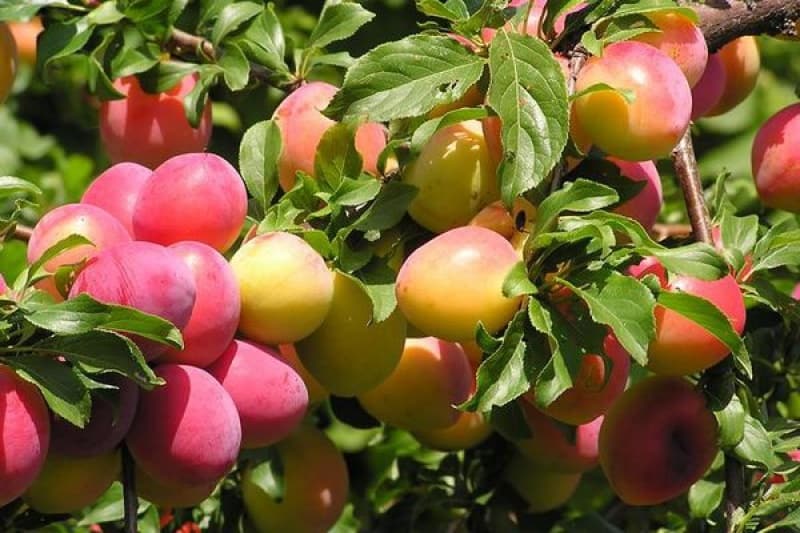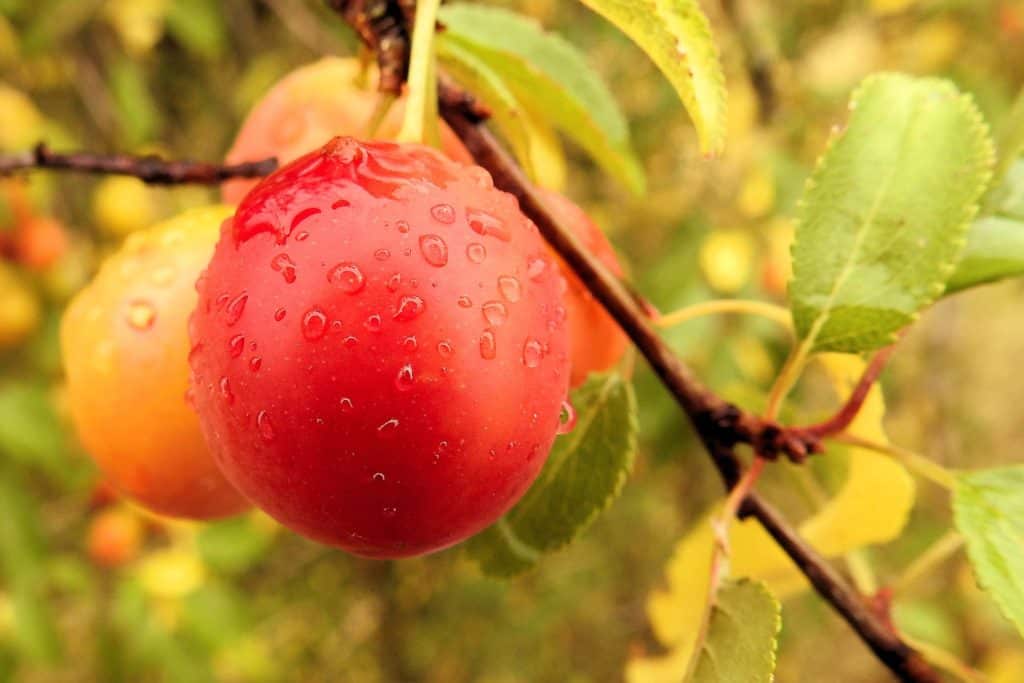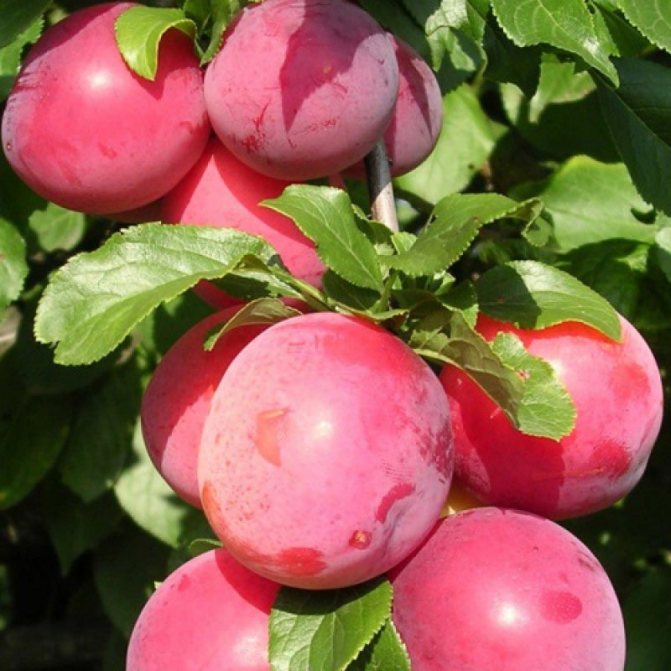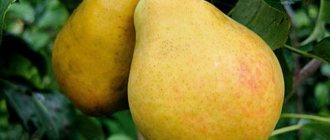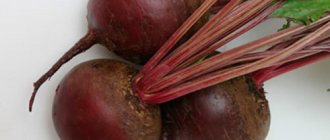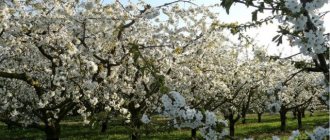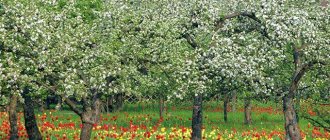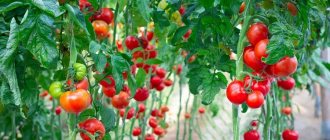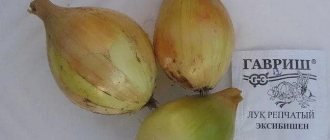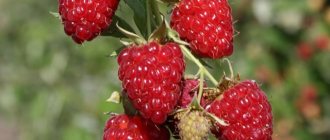In the southern regions, with their mild climate, wild cherry plum grows everywhere. In the northern regions, in the middle lane, as well as in the Moscow region, under natural conditions, it cannot grow, since it is not characterized by winter hardiness. But it easily crosses with the usual plum, more resistant to frost to sudden changes in temperature and frost. In the article we will tell you about the best varieties of cherry plum for the Moscow region, we will give their detailed description.
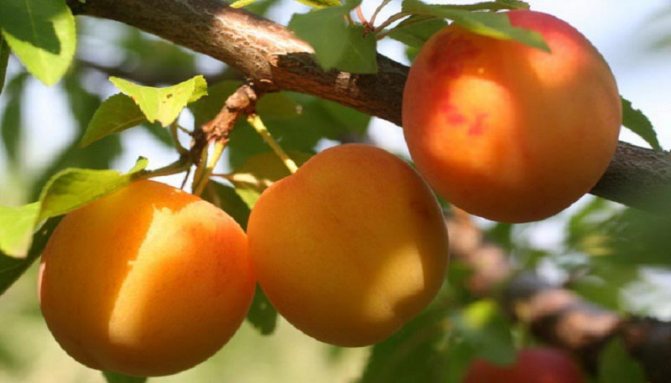
In the Moscow region, you can grow different varieties of cherry plum
The best self-fertile varieties of cherry plum for the Moscow region
Cherry plum is a self-fertile plant, but some large-fruited varieties are partially self-fertile. This means that in order to set fruits on the site, it is necessary to plant a couple of other varieties of cherry plum or plum, Chinese, American, Canadian, blooming at the same time. For them to be well pollinated, these trees need to be planted at a distance of 3-4 meters from each other.
Kuban comet
Of the red-fruited, the best was the Kuban comet variety, of early ripening (in the Moscow region - late July - early August), with tasty, large, dark red fruits, resistant to moniliosis and cracking of fruits. The tree is weak, no more than 2-2.5 m in height, with a sparse crown, without thorns, prone to forming in the form of a bush. The variety is partially self-fertile, perfectly reproduces by green and lignified cuttings. It tolerates short-term frosts well enough. Bears fruit for 2-3 years after planting. Resistant to diseases and pests.
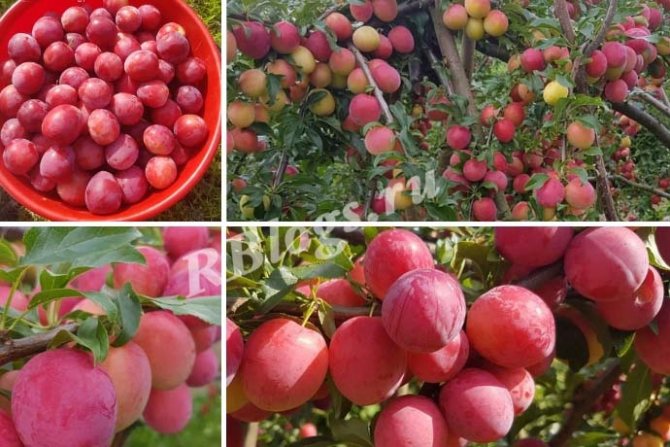

Vetraz-2
Vetraz-2 is a variety of early ripening, winter-hardy, productive, fast-growing (begins to bear fruit in the third year after planting), obtained from crossing a hybrid cherry plum with the Sino-Ussuri plum Skoroplodnaya. The tree is fast-growing, with a raised, broad-shaped crown. Leaves are dark green, shiny, elongated-elliptical. Fruits are medium in size, weighing 18 g, round-ovoid, bright yellow, with a blush, sweet and sour. The skin is of medium thickness, the flesh is greenish-yellow, slightly fibrous. The stone is round-oval, of medium size, poorly separated from the pulp. Partially self-fertile, relatively resistant to clasterosporium disease.


What do the reviews say?
Summer residents growing the Tsar's species of cherry plum have long formed their opinion about the plant. Gardeners talk about the following features of the hybrid plum:
- good taste and consistency of the pulp;
- optimal fruit weight;
- fast processing - preparation of compotes, juices, preserves and jam;
- damping of the root system, but this is eliminated by planting on small mounds;
- the absence of a variety in the State Register, therefore there is a risk of acquiring low-quality seedlings;
- fruiting from August to September;
- the need to untangle the roots when planting a young tree.


The opinions of summer residents also boil down to a comparison of cherry plums and plums. The first is not widespread enough on the territory of Russia, but is practically not damaged. Plums do not always bear fruit, while cherry plums are regularly harvested. In comparison with plum trees, cherry plums have a higher vitality. Using the information of practicing gardeners, you can choose this hybrid for planting on the site.
The best winter-hardy varieties of cherry plum for the Moscow region
In the Moscow region, the main reason for the absence or low yield of large-fruited cherry plum is the death of flower buds from recurrent frosts after thaws at the end of winter and spring frosts. Those trees in which flower buds develop slowly in spring and later flowering turned out to be more hardy than others. These properties are possessed by cherry plum varieties, in the origin of which hybrids of American plum and Bessia cherry with Chinese plum participated.
Tent
Tent - large fruits (weighing up to 60 g), the tree is undersized, begins to bear fruit at 4-5 years of age. The pulp is sweet and sour, yellow in color, such fruits can be eaten fresh and used for preparations. The average yield per tree is 35 kilograms. The ripening period is early, frost resistance is high, in addition to the winter cold, the buds also tolerate spring frosts. The disadvantages include self-infertility and average resistance to lack of moisture.
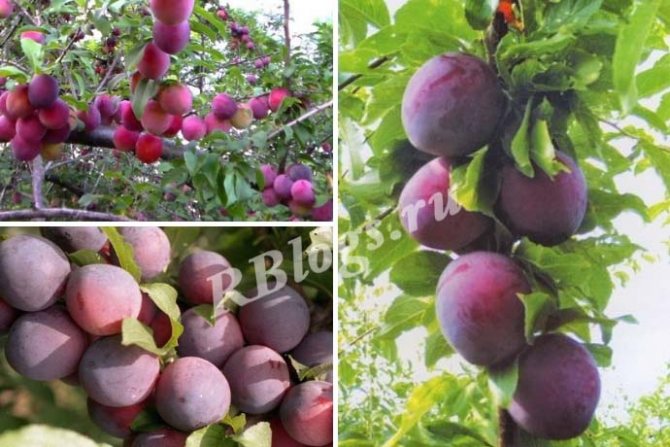

Traveler
Traveler - large, fragrant fruits of early ripening, winter-hardy enough. Early ripening. The trees are compact with a rounded crown. Fruits are medium-sized (25-30 g), bright yellow, with a reddish bloom, very aromatic. The pulp is fine-fiber, sweet and sour, the stone is separated poorly.
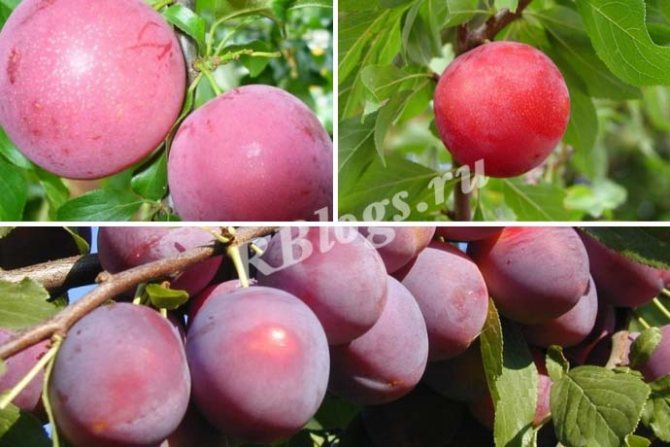

Columnar
Trees of this variety on a strong-growing rootstock reach a height of 3-3.5 m, and their crown width does not exceed 1.2-2 m. Columnar cherry plum is quite winter-hardy. Although in terms of frost resistance at rest, it is somewhat inferior to the Kuban comet, which tolerates frosts down to minus 30-32 ° C, but it can withstand the return cold at the end of winter and after thaws, since it slowly comes out of dormancy and blooms three to four days later than others cherry plum varieties.
Cherry plum fruits Columnar large, weighing up to 40 g, oval or ovoid, dark red with a light waxy bloom. Their peel is of medium thickness, strong, resistant to cracking. The pulp is of medium density, juicy, pink, with a peculiar aroma, very pleasant taste. The stone is separated when fully ripe. The fruits are suitable for fresh consumption and canning (juice with pulp, preserves, compotes, jam, etc.).
Columnar is a self-infertile variety. The pollinator for him can be any other variety of cherry plum, as well as Chinese, Ussuri plums and blackthorns. It is hygrophilous, responds well to fertilization, and is resistant to diseases.
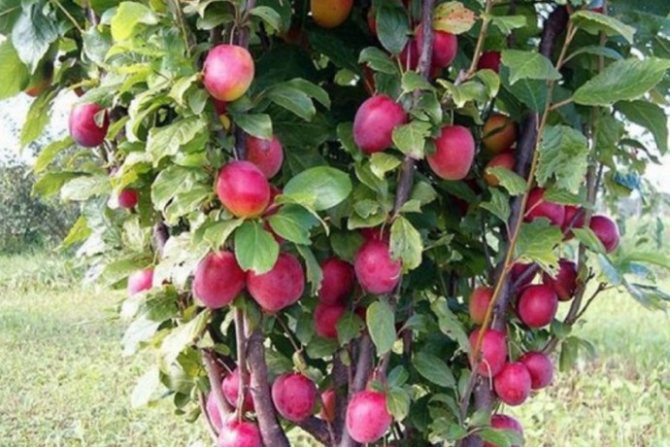

Of the other winter-hardy varieties suitable for central Russia, the most interesting are:
- Granite - Medium late grade. Winter hardy. Fruits with a waxy coating, dense pulp, juicy. The pulp is yellow;
- July rose - very early in terms of ripening, fruits up to 30 g, dark red;
- Vitba is a winter-hardy, fruitful, fast-growing variety. The tree is medium-sized, with a spherical crown of medium density. Fruits are medium, weighing 24 g, round, yellow with a reddish blush, sweet, with a pleasant aroma. The pulp is orange, tender, juicy. The stone is rather small, it separates well from the pulp;
- Asaloda is a winter-hardy, fruitful, fast-growing variety. The tree is not tall, the fruits are medium, weighing 27 g, rounded, dark red, sweet. The pulp is yellow-red, tender, juicy. The stone is small, poorly separated from the pulp.
Diseases and pests, methods of control and prevention
To protect against aphids, you need to spray the tree with a 1% solution of DNSC or laundry soap diluted in an amount of 200 g per 10 liters of water. The brown fruit mite is afraid of 10% Karbofos (75 g per 10 l of water) or 10% benzophosphate (60 g per 10 l of water). Spraying with 0.2% Metaphos or 0.3% Karbofos will protect from the plum moth, installing trapping belts made of cardboard or burlap up to 25 cm wide will help, they must be tied to the trunk.
To protect against powdery mildew, sore areas should be removed and treated with a solution of copper sulfate.As a preventive measure, treatment in April with a solution of colloidal sulfur (20 g) with the addition of copper sulfate (5 g) to a bucket of water will help. Spraying 1% Bordeaux liquid in a proportion of 100 g per bucket of water helps to get rid of rust. Moniliosis can only be removed by completely cutting the infected area of the tree with 10 cm of the healthy part. Copper sulfate is used as a preventive measure. It must be diluted in a proportion of 100 g per bucket of water and sprayed on the tree.
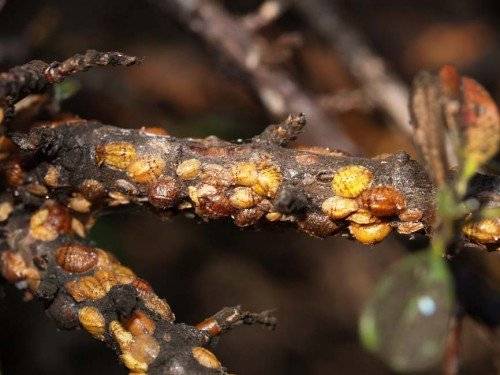

The best varieties for the Moscow region in terms of ripening
By the timing of the ripening of the cherry plum fruits, it is divided into early, medium-early, medium, medium-late and late. The term for harvesting fruits depends on the variety and the further purpose of the crop. For fresh consumption and processing for juices, mashed potatoes, seasonings, the fruits are removed in the phase of full consumer maturity, for jam and compotes - technical. Prematurely harvested cherry plums ripen poorly and do not achieve the flavor characteristic of the variety.
Early varieties of cherry plum for the Moscow region
There are very early ripening varieties of cherry plum, the harvest of which ripens in mid-July, that is, much earlier than the home plum. The best selected forms were named according to their eastern origin: Chim-Chuk, Cleopatra, Monomakh, Semiramida, Yarilo, Zlato of the Scythians, Naiad, Amazonka, etc. A brief description of some varieties is given below.
Monomakh is a variety of early ripening, fruitful, fast-growing. Fruits weighing 25 g, resemble a Monomakh hat, purple, sweet. The pulp is juicy, fibrous, the stone separates well.
Pramen is a variety of early ripening, winter-hardy, high-yielding, fast-growing. The tree is fast growing, with a spreading crown. The leaves are dark green, shiny. Fruits are medium, weighing 18.5 g, round, yellow-green, with a large number of greenish dots on the skin. The pulp is yellow, tender, juicy. The stone is small, poorly separated from the pulp.
Medium ripening varieties
The gold of the Scythians is a medium-ripening variety, fruitful, fast-growing. Fruits weighing up to 38 g, yellow, round, dessert taste, with a slight sourness at the skin. The pulp is juicy, fibrous, the bone is difficult to separate.
The Kolonovidnaya variety has a compact crown, therefore, a thickened planting is allowed for it (up to 0.5 m in a row), and it can be successfully used for decorative purposes. Fruits are large, tasty, dark red, medium ripening.
Late varieties of cherry plum
Cleopatra is a late ripening variety, fruitful (14 kg of fruits from a six-year-old tree), fast-growing. Fruits weighing up to 40 g, round, dark purple, almost black when fully ripe, with a strong waxy bloom, sweet and sour. The pulp is dense, cartilaginous, the bone is difficult to separate.
Features of growing cherry plum in the Moscow region - planting and care
When growing a large-fruited cherry plum in the Moscow region, it must be remembered that this is still a southern culture and in the garden it needs to create such conditions so that in the summer it does not feel a lack of heat, in the fall it has time to prepare well for frosts, and then it has been successfully transferred.
Place and soil
The optimal place for planting hybrid cherry plums is a site well protected from the wind, preferably on a southern slope, with light, well-warmed neutral soil. Plant it in a sunny area with good air circulation, avoid planting near trees or buildings that will shade it.
In the climatic conditions of central Russia, it is impossible to plant cherry plum on heavy waterlogged soil, since in autumn the growth of shoots on the trees will continue for a long time and because of this they will freeze strongly annually. Cherry plum grows best on well-drained, loamy, moist soils.
Landing
Propagated by grafting on seedlings of wild or cultivated cherry plum and root shoots of domestic plum, as well as green cuttings and horizontal layers.
Planting of cherry plum seedlings in the Moscow region is carried out in the spring. They are planted at a distance of 3-4 meters from each other, slightly deepening the plant to form additional roots.
Top dressing
In the first years after planting, the tree grows strongly and does not need a lot of nitrogen-containing fertilizers - a single application in early spring (20-25 g / m2) is enough. In the second half of summer, it is advisable to use phosphorus-potassium fertilizers or ash.
Pruning and shaping bushes
Shoot growth in spring begins immediately after flowering and continues until the end of July. Three waves of shoot growth are usually observed during the growing season.
Depending on the variety, large-fruited cherry plum can be formed in a tree-like or bush-like form. The growth of tall trees can be halved by using low-growing winter-hardy rootstocks VVA-1. On the 3-4th year after the laying of the main skeletal branches, the removal of the leader during the formation of trees also helps to regulate the height of plants.
The tendency of most varieties of cherry plum to naturally form in the form of bushes of two to four trunks contributes to an increase in winter hardiness, durability and rapid recovery of plants after freezing. By overlapping each other, the trunks are better protected from the weather and sunburn.
Tree propagation methods
For vegetative propagation of Tsarskaya cherry plum, grafts made using various technologies, as well as different types of cuttings, are used.


Green cuttings
In the middle of summer, cuttings 10 cm long are obtained by cutting off the fresh shoots of the growth just below the bud. 2-3 leaves remain on the branch, the lower one is removed. The stalk is rooted after soaking in a growth promoter. The root system is formed in a month.
Lignified cuttings method
During autumn leaf fall, cuttings 20-25 cm long are harvested for planting in spring. They are cut from annual shoots, removing leaves and side shoots. The blanks are stored in winter, treated with molten paraffin.
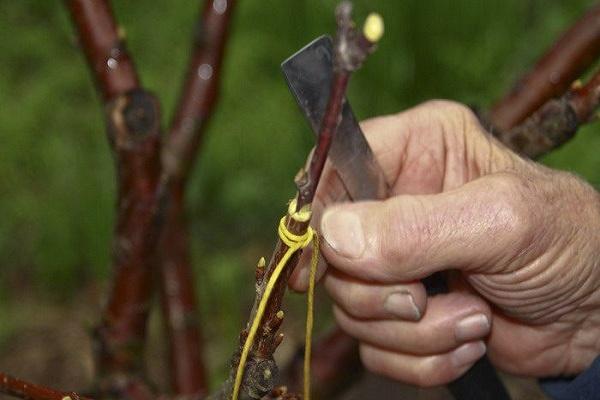

Cherry plum for the Moscow region: a holiday of taste and color
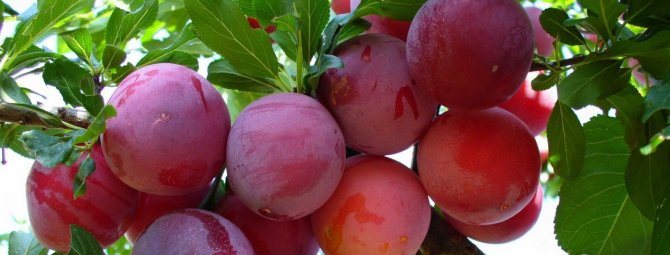

Cherry plum in natural conditions is typical for the southern regions: Crimea, North Caucasus, Central Asia. This garden culture has long been known for its juicy fruits of bright color and rich taste. Thanks to the intensive work of breeders, today varieties for growing cherry plums have also been bred in the North-West and Central regions of Russia, including in the Moscow region.
Experienced gardening tips
Gardeners with experience in growing cherry plum give the following recommendations to beginners:
- The culture does not tolerate acidic or alkaline soil. The soil should be fertilized with organic matter.
- The tree should not be watered excessively - cherry plum is sensitive to excess moisture in the soil.
- You cannot cut the culture too much - this will lead to freezing and burnout.
- It is necessary to choose the right seedlings. Only zoned varieties should be purchased and only in nurseries.
- You cannot plant a tree in deep holes with loose soil. After such a planting, the cherry plum will grow strongly and sag under its own weight. In addition, precipitation will stagnate, which will lead to decay of the root system.
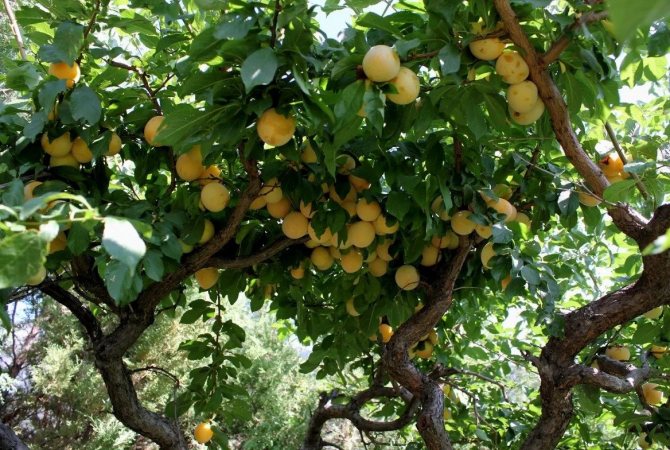

So, subject to all the rules and recommendations, even in the middle zone of Russia, namely in the Moscow region, it is possible to cultivate such a southern culture as cherry plum. The main thing is to correctly choose a variety suitable for such a region.
Source: fermer.blog
The best varieties of cherry plum for the Moscow region
Cherry plum in the diet of people is highly valued for its healthy, tasty fruits, which also have medicinal properties. And if in the south cherry plum grows without any problems, then in the Moscow region, with its unfavorable climatic conditions, it is quite difficult to grow ordinary varieties of this crop. In spring, due to cold, rainy weather, cherry plum flowers are poorly pollinated, and severe frosts in winter can damage flower buds and young shoots.In order to grow this thermophilic crop in the middle lane, it became necessary to develop zoned varieties with high winter hardiness and early ripening of fruits, as well as resistance to the main diseases of stone fruit crops. As a result of breeding work, cherry plum varieties were obtained for cultivation in the Central region, which includes the Moscow region.
Video: an overview of cherry plum varieties for the middle lane
To get rid of the negative qualities of varieties and enhance their best properties, breeders use multiple crosses between different types of plums. In the early 90s of the last century, the Russian scientist, academician G.V. Eremin, in the process of selection, bred a new variety of cherry plum, crossing the Chinese plum resistant to fungal diseases and the winter-hardy Ussuri plum with hybrids of the southern cherry plum. The new promising culture was named "Russian plum" or hybrid cherry plum. In the conditions of the Moscow region, the varieties of this cherry plum showed a fairly high winter hardiness, good quality of large, very tasty fruits and the yield is higher than that of ordinary plums.
Self-fertile varieties
Most varieties of cherry plum grown in the Moscow region are self-fertile. This means that for their high-quality pollination and fruit setting, the presence of other varieties of cherry plum or plum is necessary. However, in some species, flowers have the ability to self-pollinate, such a culture is called self-fertile. The names and characteristics of self-fertile varieties are shown in the table. In addition to these varieties, the local variety of folk selection Tulskaya and cherry plum Yayichnaya blue (selection VSTISP) are distinguished by self-fertility. It should be noted that cherry plum Morning has a high degree of self-fertility and does not require additional pollination. The Kuban comet variety is partially self-fertile and needs pollinating trees. The Vladimir comet and the Blue Dar are self-fertile varieties, but their self-fertility is rather arbitrary. If the weather is warm, dry during flowering, cherry plum flowers can be pollinated with their own pollen. This is also facilitated by the early emergence of pollinating insects: bees, bumblebees, wasps. But for guaranteed pollination and fertilization in any weather conditions, it is recommended to plant several varieties of cherry plum nearby (usually two or three varieties suitable for flowering times are enough).
Cherry plum varieties for the Moscow region
Cherry plum is not found in the wild in the cold regions of Russia and the middle zone because of the fear of winter frosts and winds. Specially for the Moscow region, by crossing with plums, varieties were artificially bred that are not afraid of frost and low temperatures. Many gardeners fell in love with multi-colored fruits with excellent taste.
Gold of the Scythians
The cultivar was entered into the State Register in 2005. Fruit tree up to 3 meters high with a wide-conical crown and small elongated light green leaves, which is recommended to form into a shrub. It blooms with white flowers that appear directly on the trunk. Produces medium yields of large fruits of bright yellow color. Has a sweet taste, soft moist pulp.
What crops are planted next to cherry plum
| Perfect Neighborhood | Unwanted neighborhood |
| Cherry plum | Pear |
| Apricot | Walnut |
| Quince | Apple tree |
| Hawthorn | |
| Blueberry | |
| Raspberries | |
| Sea buckthorn | |
| Plum |

